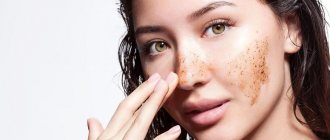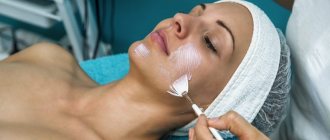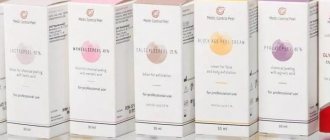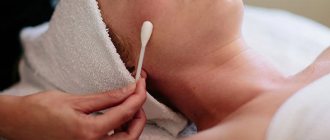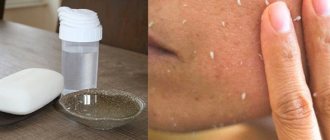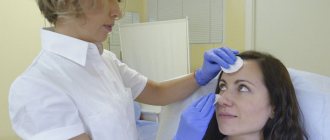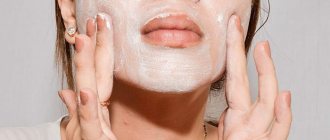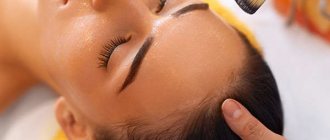Coral peeling is classified as mechanical, because the main component is sharp coral particles that act as an abrasive. Diamond peeling is considered to be an analogue of this procedure, although the technique proceeds fundamentally differently and has a slightly different effect on the skin. The most popular among coral peels are products from the Rose de Mer line, produced by the Israeli manufacturer Christina. This is a mid-surface agent that can have varying degrees of effect depending on the concentration.
What is coral peeling?
Coral peeling is an excellent treatment for acne, scars and pigmentation. Coral peel is safe, consists of natural corals and contains only 1% glycolic acid. There are no side effects, peeling does not make the skin thinner and can be used for a long time. It is not like other chemical peels. The exfoliation process will continue for 1 week after treatment and visible skin improvements can be seen after 6 treatments.
Coral peeling is ideal for treating acne. After approximately 6 treatments, the problem will stop and the skin will become much lighter and healthier. Coral peels are widely used by Korean dermatologists.
Most peelings offered for sale or used in cosmetology centers are chemical-based. The essence of their effect is to corrode the upper layers of the skin, which triggers regeneration processes and renews the surface of the face. After the old layer dies and peels off the face, the patient receives renewed, soft and velvety skin. The main thing to remember is that the natural recovery process cannot be interrupted or forced, that is, crusts with dying skin cannot be removed, they must fall off on their own.
Coral peeling, on the other hand, is made primarily on a natural basis and has a gentler effect on the skin. The degree of impact directly depends on the application technique.
- Firstly, it differs from all other types of peelings in that it contains abrasive particles. Other peels consist almost entirely of acids and additional substances.
- Secondly, coral peeling does not contain (or contains in extremely low concentrations) acid. This completely changes the way the substance affects the skin.
It has a more mechanical effect, so the recovery process is somewhat different from other, more familiar methods. But, still, it is better not to touch your face again until complete recovery; you should also refuse the services of salons that promise to speed up the process with the help of healing drugs.
Always check with your cosmetologist the composition of the drug used and ask to what extent the substance will affect the skin
Technique
To obtain a high-quality result and neutralize possible problems, it is recommended to carefully follow the manufacturer’s instructions and follow all stages of the procedure.
Preparatory stage
It is necessary to cleanse the skin with peeling soap. Its application:
- will provide primary exfoliation of “old” particles of the epidermis;
- will open comedones;
- balances the secretion of the sebaceous glands;
- will have an anti-inflammatory effect;
- prepares the tissue for further manipulation.
Main stage
Depends on the chosen method and means, it is important to listen to the advice of a professional cosmetologist.
For soft peeling (impact on the surface layer of the skin):
- dilute the powder with the activator in a ratio of 1:1;
- apply the resulting mass to the entire surface to be treated;
- hold for 5 minutes.
Light peeling does not involve rubbing the product into the skin.
For classic peeling:
- dilute the powder with the activator in a ratio of 1:1;
- apply the resulting mixture to the face, avoiding areas around the eyes and lips;
- rub in with gentle movements for about 2 minutes (to affect only the stratum corneum of the skin) or for 5-10 minutes (to penetrate to the granular layer of the skin).
We recommend: How to get rid of age spots using peeling in the salon and at home? Precautions and expert advice
Final
Consists of post-peeling procedures, including application of a mask, gel and cream. At this stage it is recommended:
- apply a soothing mask from the same series as the main products; it will absorb excess fat, relieve irritation, tighten pores and have an absorbent effect;
- apply a post-peeling gel that protects the skin from pollution and unwanted environmental influences; the product retains the active components of the peeling inside the pores;
- Apply a post-peeling protective cream that has antibacterial and antifungal properties and masks skin defects.
Post-peel protection may include additional medications and be used after any active procedures.
How coral peeling works
The main difference between coral and other types of peelings is that it has an abrasive substance and in some cases acts more gently than acid-containing preparations. On the other hand, why go to a salon for this procedure if you can use regular scrubs, which also have various particles that help exfoliate? But home scrubbing is different. The mild type of coral peeling differs from a regular scrub as it does not damage or dry out the skin. This is precisely the main advantage when compared with self-scrubbing. How is this peeling carried out? The procedure, with a certain application technique, is almost painless and for this reason it is often performed on men who tolerate pain during sessions worse than the fair sex. The mass is evenly applied to the surface of the skin, after which the cosmetologist treats each area of the face with soft massage movements.
Another advantage of this product is that it can be used even on the thinnest and most sensitive skin.
On average, the procedure should be performed 1-2 times a week, but the exact number of sessions should be determined by the attending physician. On the other hand, there are a number of peelings that have a more aggressive composition and affect the skin more actively. These drugs include Rose de Mer Christina, which is able to affect the deeper layers of the dermis (depending on the method of facial treatment and the intensity of the massage). After a session using such peeling, the patient experiences all the “delights” of peeling treatment: tingling, pain throughout the day, dryness and tightness of the skin, cracks in the upper layers of the epidermis.
The application method and type of drug are determined by the attending physician on an individual basis.
With caution: physical peels
Acceptable hardware peels for rosacea, or more precisely, its visual manifestations, come down to cleansing the skin using ultrasound and a gas-liquid solution.
- Ultrasound peeling. Acoustic waves act superficially and do not damage the deep layers of the epidermis. Heating the subcutaneous tissue in this case has a beneficial effect - ultrasound stimulates blood flow and has a massage effect;
- Oxygen (gas-liquid) peeling. In this case, the correction of the vascular network occurs using a gas-liquid jet, which is applied to the facial skin under high pressure. Saline solution, distilled water or medication is enriched with oxygen. The product exfoliates old cells and promotes capillary drainage;
- Carbon peeling is a combination of chemical and physical peeling. Carbon nanogel under the influence of laser radiation helps get rid of rosacea.
Other common physical facial peels, such as microcrystalline dermabrasion, cryotherapy or laser resurfacing, are contraindicated for rosacea.
Pros of coral peeling (4 benefits)
The main advantage of the product is its complete naturalness:
- The main ingredients are crushed coral from the Red Sea, shea butter and Dead Sea salts.
- The algae included in the preparation has a high amount of antioxidants, which have a beneficial effect on all layers of the skin.
- Abrasive particles help deliver active substances to the middle layers of the skin. After treatment with abrasive particles, the face becomes more susceptible to the active substances contained in other components.
- Shea butter deeply nourishes and moisturizes the skin, making it soft and velvety. Thus, the skin is exfoliated and nourished at the same time.
Types of coral cleaning
Modern cosmetological developments suggest the use of coral abrasives in two types of peeling, depending on the proportions and area of their application.
Classic peeling. Sometimes it is also called medium peeling. It is distinguished by the duration of exposure, and all nutrients penetrate into the middle part of the skin. Coral in the form of small particles, the main component of the peeling, is applied to the skin with gentle, light movements so that not a single particle disappears from the affected area. With such careful technique, the cosmetologist achieves deep penetration of the substance under the skin, high-quality exfoliation in order to effectively cleanse the skin and provide it with useful substances.
Classic peeling stimulates the upper and middle layers of the skin, starting the process of exfoliation, regeneration and further renewal of the skin.
Soft peeling. This peeling, due to the herbal extracts in its composition, provides a softening effect for the skin. Basically, the scope of his activity is superficial, he eliminates minor facial skin problems.
Soft peeling is a short procedure during which the product is simply applied to the face, without rubbing, and ten minutes later it is removed from its surface. Thus, the stratum corneum is eliminated, and the skin itself is saturated with nutrients and vitamins, becoming elastic, smooth and velvety.
How is the procedure done? (step by step)
Experts recommend undergoing the procedure in a salon, because a cosmetologist will help you achieve the best results. The session proceeds as follows:
- the patient lies in a horizontal position and takes a comfortable position;
- the cosmetologist applies skin milk or other cleanser that will prepare and moisturize the epidermis;
- after cleansing, a certain amount of product is applied, the exact dose is determined by the doctor depending on the condition of the skin;
- With light massage movements, the peeling is rubbed into the skin for 5-15 minutes;
- After treatment, the skin is cleansed and special moisturizing and nourishing products are applied to it.
Each doctor chooses an individual method of applying the drug and, depending on the skin type, determines the concentration of the substance.
The frequency of procedures is also determined privately; on average, the session must be repeated 1-2 times a week.
Can it be done at home?
To use peeling at home, it is better to use a specialized “light” line of products. It includes:
- cleansing and peeling soap that gently exfoliates dead cells, renews the skin and eliminates the causes of hyperkeratosis;
- cream to increase skin elasticity, penetrating deeply into tissues, smoothing and tightening them;
- post-peeling protective cream that promotes cell regeneration and neutralizes inflammation;
- additional post-peeling care products (gels, masks, etc.).
Manufacturers warn that the use of basic products requires additional training. You can use professional coral-based preparations at home only in extreme cases and only after similar procedures have been carried out under the supervision of specialists.
What results should I expect from the procedure?
The result directly depends on the dosage of the product and the time it was on the skin.
If you rub the drug too vigorously, severe peeling may occur, up to the separation of the top layer of dead epidermis. After regeneration, the skin becomes soft, velvety, pores are tightened, and blackheads disappear completely or become almost invisible.
If the procedure is carried out carefully, there will be no recovery period. The patient will be able to return to a normal lifestyle and not feel discomfort.
This drug is perfect for people suffering from allergies. Coral chips (aka dust), which is part of the product, extremely rarely cause allergic reactions. Most allergy sufferers tolerate this procedure calmly and without complications. Anyone over 35 years of age can perform the procedure. There are a number of indications for which coral peeling is most relevant.
Possible complications
As a rule, there are no complications after coral peeling. Discomfort in the first days after the procedure is normal for all types of deep skin cleansing. But individual reactions of the body or violations in care can lead to such unpleasant consequences as:
- allergic reactions;
- local swelling;
- hyperemia;
- painful sensations;
- increased skin sensitivity;
- tissue infection.
Any type of peeling can cause such complications.
How to care for your skin after the procedure?
In order for the effect to be as expected, it is worth paying attention to the recovery period. During the first 24 hours, it is better not to touch the skin or undergo various cosmetic procedures. In addition, it is recommended to postpone visiting the pool or gym for about 5 days. The fact is that this will cause the skin to begin to turn red, which increases the risk of developing bacteria.
Many experts advise laying out clean linen, which is best ironed first.
But after 3-4 days, washing with mild gels is already allowed. But there is no need to use creams, as complete exfoliation must take place. It is strictly forbidden to peel off the crusts that have appeared, otherwise you risk experiencing pigmentation or other unpleasant consequences. After peeling, you need to go outside after protecting your face with UV protection cream. By the way, some high-level salons provide detailed instructions on how to behave after the procedure on a daily basis, which is very convenient.
Stages
Facial cleansing involves several stages. Coral scrub does not require any preparatory measures. At the same time, in order to achieve a better result, cosmetologists recommend carrying out yellow peeling of a superficial effect a month before the procedure.
Execution order:
- Inspection and choice of tactics. The specialist assesses the condition of the skin and determines the duration of exposure to the composition. The intensity depends on the problems and the degree of their neglect.
- Cleansing. Removes residues of cosmetics, sebaceous secretions and other contaminants.
- Treatment with a pore opening agent. This will make the process of removing sebaceous plugs and comedones easier. Keep the composition on the face for a short time, then remove the marks with a napkin.
- Applying peeling. The coral composition is evenly distributed over the surface. Perform facial massage for 2-10 minutes. At the same time, the patient feels a slight tingling sensation, which becomes stronger every minute.
- Removing the scrubbing agent.
- Applying a cold bandage. Eases discomfort after the procedure and relieves skin irritation.
- Applying moisturizer. Perform in 10-15 minutes.
Question answer
Jessner is another type of peeling. The degree of intensity of exposure can be selected individually. Coral peeling Rose de Mer from the manufacturer Christina also has several degrees of impact. The patient can only choose whether he wants to use an exfoliating agent or a classic one - corrosive.
It is not recommended to carry out peeling in the summer because ultraviolet rays cause pigmentation, and in especially advanced cases cause skin cancer.
The first day you should expect redness and a burning sensation, which will disappear after 7 hours. On the second day, the skin will begin to tighten and a brownish tint will appear. On the third day, the surface of the face will be covered with a film, and in the future you should expect it to crack (it is forbidden to peel it off yourself, there is a risk of encountering pigmentation). On days 5-7 you can evaluate the result.
Types of Rose de Mer peelings (3 types)
High-quality products from a well-known brand are completely safe for human health and consist of natural ingredients of organic origin.
There are several types of peels, each of which has unique properties and differs in the method of application.
Peeling with vitamin E
The product is sold in 250 ml plastic containers. Gommage has a dense structure and a light, specific aroma. Color – white with a greenish tint.
The basis of the drug:
- ground seaweed;
- Dead Sea salt;
- extracts from Brazilian medicinal plants;
- vitamins E, A.
Peeling is intended for gentle cleaning of the surface of the epidermis, suitable for any age and skin type.
Gommage is applied according to the following scheme:
- The epidermis is thoroughly cleansed.
- The product is applied with a brush or fingertips.
- After this, you need to wait until the mass dries completely.
- Those with oily and normal skin remove the composition using rolling movements, always along massage lines.
- Women with thin and sensitive skin remove the product by wetting their face with warm water. This method protects against damage.
- The remaining peeling is washed off.
- The surface of the face is moisturized with cream or serum.
User reviews of Rose de Mer Christina peeling, enriched with vitamin E, indicate a large number of beneficial properties of this procedure:
- gentle exfoliation;
- leveling the relief and improving color;
- increased elasticity;
- stimulation of cellular recovery;
- slight whitening;
- decreased sebum production.
The average price is from 1800 rubles.
Coral peeling
The drug is sold in powder form and has a dark color. Before use, dilute with a special solution. The basis of the drug:
- Salt extracted from the Dead Sea.
- Ground corals.
- Useful minerals.
- Proteins and acids of plant origin.
- Vitamins E, A.
Reviews of Rose de Mer coral peeling indicate an average level of impact. Application occurs according to the following scheme:
- the skin is cleansed in the usual way;
- the mass is rubbed in with gentle movements for 5 minutes;
- at this moment, a tingling sensation is felt on the face, this is how the effect of coral crumbs manifests itself, which quite aggressively removes dead skin cells of the epidermis;
- the face is covered with a moistened cloth for 10 minutes to expose the salt and other beneficial components;
- the remaining mass is removed with wet wipes. The skin tingles and “burns,” which is normal after the procedure.
For oily types, after cleansing, apply a mask with a vasoconstrictor and moisturizing effect.
Over the next 2–3 days, tolerable pain is felt. But there is no need to worry, this deficiency goes away on its own.
The procedure using coral pinning has a renewing and therapeutic effect:
- treats acne, including advanced stages;
- eliminates post-acne;
- tightens pores;
- reduces the severity of age spots;
- removes signs of rosacea and spider veins;
- prevents the appearance of age-related changes: smoothes wrinkles, increases elasticity;
- improves facial structure;
- restores healthy color.
Reviews and before and after photos allow you to see the results of using the Rose de Mer peeling.
The average cost of the product is 1,500 rubles.
Soap peeling
The drug is sold in the form of a round bar of soap, colored brownish-brown.
In its structure you can see particles of crushed algae; the surface is rough to the touch due to the presence of coral powder.
The basis of the product:
- coral powder;
- Dead Sea salt;
- ground seaweed;
- extracts from Brazilian plants.
The manufacturer claims that the effect of the drug is superficial, gentle, and suitable for all ages. The product perfectly cares for oily and problematic skin and serves as a preparation for mid-cleansing.
Soap facial peeling Rose de Mer from Christina is used as follows:
- The skin is cleansed using cleansing foam and lotion.
- Place the soap bar in warm water for 20 seconds.
- You need to gently touch the face with soap, following the massage lines, without effort, until foam appears. You can lather the product in your palms and then apply it to the skin;
- A gentle massage is carried out for 10 minutes.
- The resulting foam is thoroughly washed off with running water.
- A care product with a moisturizing effect is applied to the face.
The main advantages of soap peeling include:
- treatment of acne, inflammation, pustules, blackheads;
- eliminating the manifestations of seborrhea on the scalp;
- smoothing the skin texture;
- improvement of complexion;
- activation of blood microcirculation;
- preparation of the epidermis for subsequent exposure to active substances;
- reduction of pores;
- giving tone and freshness.
On average, one piece of soap (30 g) will cost 800 rubles.
A session using Rose de Mer peeling in salons in Novosibirsk and other large cities costs approximately 2,300 rubles.
Main indications
Coral peeling can be used for both preventive and therapeutic purposes. This remedy helps fight certain problems.
INDICATIONS
- Acne scars. During the period when the disease is not in the acute stage and is hidden, the patient can begin using peeling as a means to help get rid of scars. Minor defects can be completely eliminated, while pronounced ones will become less noticeable.
- Hyperpigmentation. Age-related changes may appear as spots on the skin. These marks can be eliminated through deep action on the skin. One course consisting of several procedures will help get rid of stains.
- Decreased or loss of facial muscle tone. A deep effect on the dermis can trigger regeneration processes on various layers of the skin. Numerous studies have shown that injury to the upper layers can affect muscle tone - they begin to contract and become more toned. Ultimately, the patient receives firmer skin.
- Enlarged pores and stretch marks on the skin. They can be removed only if, along with coral peeling, other products are used - hyaluronic acid, vitamin complexes and other procedures. If you combine skin treatment with coral peeling with wraps, the boundaries of stretch mark scars will become less noticeable, and as the active substances penetrate the inner layers of the dermis, it will become more elastic and fresh. When the pores are enlarged, the skin is polished; with careful treatment with coral microparticles, the upper layers become soft and velvety. The pores are narrowed due to the removal of impurities, and during the regeneration process the skin begins to tighten.
Coral peeling can be considered as a primary remedy; it can also be no less useful as an additional procedure. But, like any other remedy, this type of peeling can be useless for certain problems, or even harmful.
Peeling effect for skin rosacea
If the peeling technique in the presence of rosacea is selected correctly, this allows you to solve a number of problems:
- Destroy the connections between deformed capillaries and create conditions for the regeneration of new tissues without cosmetic defects. Chemical peeling techniques using an acid composition and laser techniques help with this;
- Improve skin microrelief by destroying microvascular connections. As a result, the so-called stars and threads disappear on the skin;
- Achieve skin rejuvenation, eliminate fine expression wrinkles, restore skin tone;
- Eliminate pigment spots, prevent the appearance of acne.
Contraindications for use
A person should refrain from undergoing this procedure if there are certain contraindications.
CONTRAINDICATIONS
- Acne in the active stage. Even in the presence of hidden and deep-seated inflammatory processes with suppuration, peeling should be avoided. The fact is that a rash localized in one or several areas will be transferred throughout the entire face during treatment. This will inevitably lead to the spread of acne throughout the face, which is extremely dangerous when using peeling, because it damages the upper layers of the dermis, making it sensitive to any changes. Ultimately, you can develop a more aggravated form of the rash and deep scars may appear during treatment.
- Demodecosis. Exfoliation can spread the mite throughout the skin in the same way as with acne. Patients prone to increased tick activity should avoid using the product.
- Herpes in the acute stage. Herpes blisters should not be injured, and purulent fluid should not be spread over the skin, otherwise complications may occur.
In the above cases, you should completely abandon the procedure. In summer, peeling is contraindicated. Even in winter, it is necessary to use special creams with SPF filters with a value of at least 50. If in some clinic a cosmetologist begins to assure patients that in many warm countries the sun is active all year round and peeling is not dangerous even in hot seasons, then you should refuse the services of such a specialist. In warm countries, patients are forced to stay at home throughout the entire recovery period and comply with a number of additional conditions, which significantly increase the cost of the technique.
Error-free procedure: important recommendations
Any course of peeling in case of rosacea should be preceded by a consultation with an experienced cosmetologist. The specialist will advise which type of exfoliation is suitable in your case, what concentration of the composition is needed and how many sessions are permissible to restore the attractiveness of your face.
- skin areas with rosacea are treated with peeling preparations last, and neutralized first;
- a course of peelings for symptoms of rosacea has a limited number of sessions, which must be separated by at least a two-week break;
- During the recovery period after the course, the patient begins pre-orally taking medications that strengthen the walls of blood vessels and multivitamin complexes with a high content of microelements of groups P and K. It is better to find out what these medications will be from the attending physician, because all medications have a number of contraindications.
The protocol for peeling procedures for rosacea is specific. Unlike conventional exfoliation, these sessions are shorter and less frequent; due to the long break between peels, the course becomes longer. Therefore, it is better to plan it for the autumn-winter period.
Reviews
ANNA, 37 YEARS OLD, MOSCOW:
“The 35-year mark has been passed. Although I have been taking care of my skin since my youth, I still could not avoid age-related problems. The procedure was not as painless as they promised, and the recovery period was long; I only started to recover after 10 days.
This was my first peel, the next one will be with lactic acid. But I’m satisfied with the results - the skin has become somehow fresher, the wrinkles have not exactly smoothed out, but they have become less pronounced.”
SOFIA, 34 YEARS OLD, MOSCOW:
“I am a big fan of peelings, because I have oily skin and large pores. If I had not discovered these products, I would have continued to use scrubs, which only increase peeling and give a temporary effect. Coral peeling was a revelation for me. I had a delicate procedure, but the effect amazed me. No dryness. The first 3 days the skin was tight, but after recovery it became the same as when I was 25 years old. The price for the procedure was 5 thousand in a good salon with all the accompanying care procedures.”
Tips and recommendations from cosmetologists
Basic advice from cosmetologists boils down to the following:
- consultation with specialists is necessary to determine the condition of the skin and the appropriate type of coral peeling;
- when preparing for peeling, it is worth doing a test for an allergic reaction (apply a little product to the elbow and leave for 24 hours);
- When carrying out the procedure at home, you should use only products intended for use at home; It’s better not to engage in amateur activities with a professional series;
- Manipulations can only be performed with gloves;
- do not ignore the preparatory and post-peeling stages of the procedure;
- Strictly follow all recommendations for skin care after peeling.
Most cosmetology clinics and salons with a good reputation offer their patients, who have no contraindications, to try deep skin cleansing using coral peeling and guarantee a good result.
Using coral peeling is one of the safest and most effective ways to deep cleanse your face. Consultations with cosmetologists, careful preparation for the procedure, its correct implementation and adherence to recommendations for skin care during the post-peeling period will help to significantly improve the result and reduce the likelihood of complications.
Expert opinion
- Cosmetologist
- Surgeon
Irina Dorofeeva
practicing cosmetologist
I consider coral peeling to be an aggressive procedure, and I do not always recommend it to my patients. After it, the skin receives enormous stress. This is evidenced by difficult rehabilitation, when the face is covered with a film, which subsequently cracks. This is an unpleasant phenomenon. But it still has an effect, and it’s quite good.
Sanas Kharirchyan
plastic surgeon
After the procedure, the skin really looks much better.
I recommend doing about 4 procedures to achieve maximum effect. When the skin begins to peel, you should start using products to moisturize and nourish it. Even regular baby cream is suitable for this. You should definitely use sunscreen, they should be used even after recovery. Despite such “scary” words, such as “corrosive” or “traumatic,” peeling acts almost at the cellular level. Although the procedure is unpleasant, it does not pose a serious threat to the skin. The likelihood of getting a serious burn if the procedure is carried out correctly is practically reduced to zero. All the patient needs to do is choose a highly qualified specialist who will use a quality product. Following the rules of skin care will help you recover quickly and get the best results.
Classification
Rose de Mer peelings are classified according to their conditions of use. Manufacturers offer lines of drugs for carrying out procedures in professional and home conditions.
Both the professional and home line of products are supplemented with products for post-peeling skin care.
- Products for professional use:
- soap with a disinfecting and light exfoliating effect; used at the stage of preparation for the procedure;
- rich peeling based on marine vegetation (in powder form); characterized by a high exfoliating effect;
- light peeling (in powder form); recommended for eliminating pigmentation and acne on the face, goose bumps, peeling and roughness of body skin;
- activator for diluting the composition.
- Products for home use:
- soap with natural exfoliating ingredients, which has a comprehensive effect on the condition of the skin;
- soap with disinfectant and mild exfoliating effect; used at the stage of preparation for the procedure.
Basic peeling products are not included in the home series.
